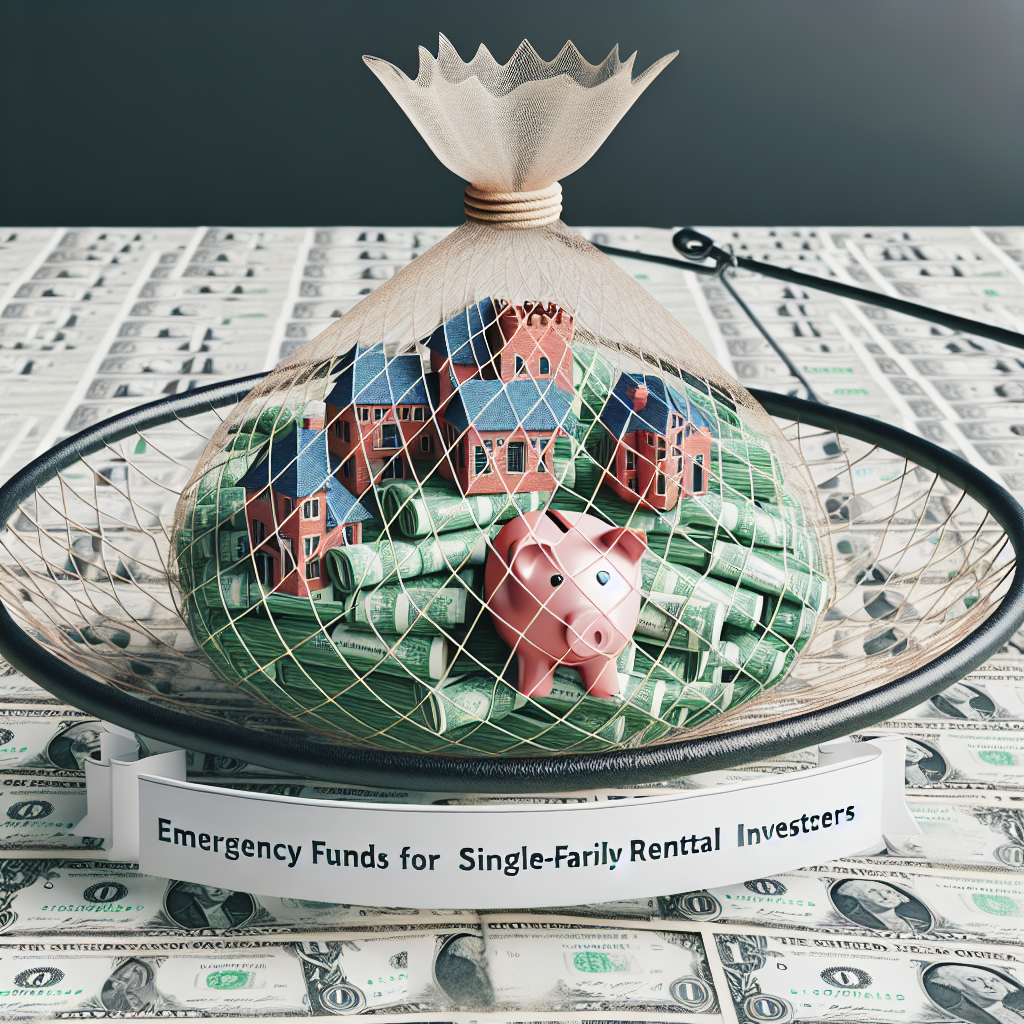-
Table of Contents
- Building a Safety Net: Emergency Funds for Single-Family Rental Investors
- Why Emergency Funds Are Crucial for Single-Family Rental Investors
- Determining the Size of Your Emergency Fund
- Assessing Property Condition
- Calculating Monthly Expenses
- Considering Vacancy Rates
- Building Your Emergency Fund
- Set Clear Goals
- Create a Budget
- Automate Savings
- Utilize Windfalls
- Maintaining Your Emergency Fund
- Regularly Review and Adjust
- Replenish After Use
- Keep Funds Accessible
- Case Studies: Real-World Examples
- Case Study 1: The Unexpected Roof Repair
- Case Study 2: Navigating a Prolonged Vacancy
- Statistics: The Impact of Emergency Funds
- Conclusion: The Key Takeaways
Building a Safety Net: Emergency Funds for Single-Family Rental Investors

Investing in single-family rental properties can be a lucrative venture, offering steady income and potential appreciation. However, like any investment, it comes with its own set of risks. One of the most effective ways to mitigate these risks is by establishing a robust emergency fund. This article delves into the importance of emergency funds for single-family rental investors, how to build one, and best practices for maintaining it.
Why Emergency Funds Are Crucial for Single-Family Rental Investors
Emergency funds serve as a financial cushion that can help investors navigate unexpected expenses and economic downturns. Here are some key reasons why having an emergency fund is essential:
- Unforeseen Repairs: Properties can require sudden repairs due to natural disasters, tenant damage, or aging infrastructure.
- Vacancy Periods: There may be times when the property is vacant, leading to a temporary loss of rental income.
- Market Fluctuations: Economic downturns can affect rental demand and property values.
- Legal Issues: Landlords may face legal challenges that require financial resources to resolve.
Determining the Size of Your Emergency Fund
The size of your emergency fund will depend on several factors, including the number of properties you own, their condition, and your financial situation. Here are some guidelines to help you determine the appropriate size:
Assessing Property Condition
Older properties or those in need of significant repairs may require a larger emergency fund. Conduct a thorough inspection to identify potential issues and estimate repair costs.
Calculating Monthly Expenses
Calculate your monthly expenses, including mortgage payments, property taxes, insurance, and maintenance costs. A common recommendation is to have three to six months’ worth of expenses saved in your emergency fund.
Considering Vacancy Rates
Research the average vacancy rates in your area. Higher vacancy rates may necessitate a larger emergency fund to cover periods without rental income.
Building Your Emergency Fund
Building an emergency fund requires discipline and strategic planning. Here are some steps to help you get started:
Set Clear Goals
Determine the amount you need to save and set a realistic timeline for achieving your goal. Break it down into smaller, manageable milestones to stay motivated.
Create a Budget
Develop a budget that outlines your income and expenses. Identify areas where you can cut costs and allocate those savings to your emergency fund.
Automate Savings
Set up automatic transfers from your rental income to your emergency fund. This ensures consistent contributions and reduces the temptation to spend the money elsewhere.
Utilize Windfalls
Use unexpected income, such as tax refunds or bonuses, to boost your emergency fund. This can accelerate your progress and provide additional security.
Maintaining Your Emergency Fund
Once you’ve built your emergency fund, it’s important to maintain it. Here are some best practices to ensure your fund remains intact:
Regularly Review and Adjust
Periodically review your emergency fund to ensure it still meets your needs. Adjust the amount as necessary based on changes in your expenses, property portfolio, or market conditions.
Replenish After Use
If you need to dip into your emergency fund, make it a priority to replenish it as soon as possible. This ensures you’re prepared for future unexpected expenses.
Keep Funds Accessible
Store your emergency fund in a liquid account, such as a high-yield savings account or money market account. This allows you to access the funds quickly when needed.
Case Studies: Real-World Examples
To illustrate the importance of emergency funds, let’s look at two real-world examples:
Case Study 1: The Unexpected Roof Repair
John, a single-family rental investor, owned a property that was generating steady rental income. One winter, a severe storm caused significant damage to the roof, requiring immediate repairs. Fortunately, John had an emergency fund that covered the $10,000 repair cost, allowing him to address the issue promptly without financial strain.
Case Study 2: Navigating a Prolonged Vacancy
Susan owned a rental property in a city experiencing an economic downturn. As a result, her property remained vacant for six months. Thanks to her emergency fund, Susan was able to cover her mortgage payments and other expenses during this period, avoiding foreclosure and maintaining her investment.
Statistics: The Impact of Emergency Funds
Statistics highlight the importance of emergency funds for rental property investors:
- A survey by the National Association of Realtors found that 40% of real estate investors experienced unexpected expenses in the past year.
- The same survey revealed that investors with emergency funds were 50% more likely to handle these expenses without financial distress.
- According to a study by the Urban Institute, properties with emergency funds had a 30% lower risk of foreclosure during economic downturns.
Conclusion: The Key Takeaways
Building and maintaining an emergency fund is a critical component of successful single-family rental investing. By preparing for unforeseen expenses, vacancy periods, and market fluctuations, investors can protect their investments and ensure long-term financial stability. Key takeaways include:
- Emergency funds provide a financial cushion for unexpected expenses and economic downturns.
- The size of your emergency fund should be based on property condition, monthly expenses, and vacancy rates.
- Building an emergency fund requires setting clear goals, creating a budget, automating savings, and utilizing windfalls.
- Maintaining your emergency fund involves regular reviews, replenishing after use, and keeping funds accessible.
- Real-world examples and statistics underscore the importance of having an emergency fund for rental property investors.
By following these guidelines, single-family rental investors can build a robust safety net that safeguards their investments and provides peace of mind.








